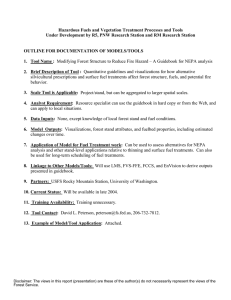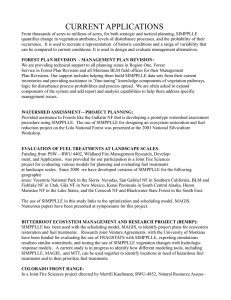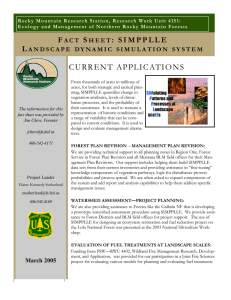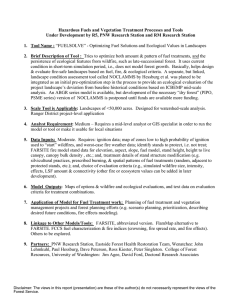Modeling Fuel Treatment Costs on Forest David Calkin Station, Missoula, MT 59801.
advertisement
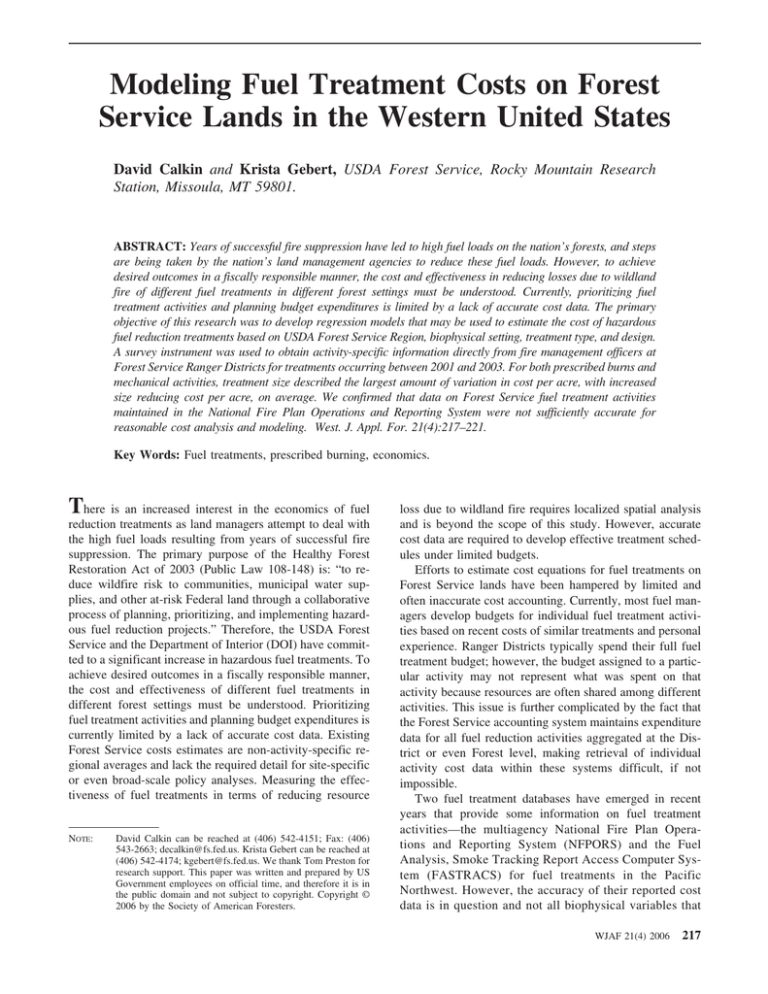
Modeling Fuel Treatment Costs on Forest
Service Lands in the Western United States
David Calkin and Krista Gebert, USDA Forest Service, Rocky Mountain Research
Station, Missoula, MT 59801.
ABSTRACT: Years of successful fire suppression have led to high fuel loads on the nation’s forests, and steps
are being taken by the nation’s land management agencies to reduce these fuel loads. However, to achieve
desired outcomes in a fiscally responsible manner, the cost and effectiveness in reducing losses due to wildland
fire of different fuel treatments in different forest settings must be understood. Currently, prioritizing fuel
treatment activities and planning budget expenditures is limited by a lack of accurate cost data. The primary
objective of this research was to develop regression models that may be used to estimate the cost of hazardous
fuel reduction treatments based on USDA Forest Service Region, biophysical setting, treatment type, and design.
A survey instrument was used to obtain activity-specific information directly from fire management officers at
Forest Service Ranger Districts for treatments occurring between 2001 and 2003. For both prescribed burns and
mechanical activities, treatment size described the largest amount of variation in cost per acre, with increased
size reducing cost per acre, on average. We confirmed that data on Forest Service fuel treatment activities
maintained in the National Fire Plan Operations and Reporting System were not sufficiently accurate for
reasonable cost analysis and modeling. West. J. Appl. For. 21(4):217–221.
Key Words: Fuel treatments, prescribed burning, economics.
T
here is an increased interest in the economics of fuel
reduction treatments as land managers attempt to deal with
the high fuel loads resulting from years of successful fire
suppression. The primary purpose of the Healthy Forest
Restoration Act of 2003 (Public Law 108-148) is: “to reduce wildfire risk to communities, municipal water supplies, and other at-risk Federal land through a collaborative
process of planning, prioritizing, and implementing hazardous fuel reduction projects.” Therefore, the USDA Forest
Service and the Department of Interior (DOI) have committed to a significant increase in hazardous fuel treatments. To
achieve desired outcomes in a fiscally responsible manner,
the cost and effectiveness of different fuel treatments in
different forest settings must be understood. Prioritizing
fuel treatment activities and planning budget expenditures is
currently limited by a lack of accurate cost data. Existing
Forest Service costs estimates are non-activity-specific regional averages and lack the required detail for site-specific
or even broad-scale policy analyses. Measuring the effectiveness of fuel treatments in terms of reducing resource
NOTE:
David Calkin can be reached at (406) 542-4151; Fax: (406)
543-2663; decalkin@fs.fed.us. Krista Gebert can be reached at
(406) 542-4174; kgebert@fs.fed.us. We thank Tom Preston for
research support. This paper was written and prepared by US
Government employees on official time, and therefore it is in
the public domain and not subject to copyright. Copyright ©
2006 by the Society of American Foresters.
loss due to wildland fire requires localized spatial analysis
and is beyond the scope of this study. However, accurate
cost data are required to develop effective treatment schedules under limited budgets.
Efforts to estimate cost equations for fuel treatments on
Forest Service lands have been hampered by limited and
often inaccurate cost accounting. Currently, most fuel managers develop budgets for individual fuel treatment activities based on recent costs of similar treatments and personal
experience. Ranger Districts typically spend their full fuel
treatment budget; however, the budget assigned to a particular activity may not represent what was spent on that
activity because resources are often shared among different
activities. This issue is further complicated by the fact that
the Forest Service accounting system maintains expenditure
data for all fuel reduction activities aggregated at the District or even Forest level, making retrieval of individual
activity cost data within these systems difficult, if not
impossible.
Two fuel treatment databases have emerged in recent
years that provide some information on fuel treatment
activities—the multiagency National Fire Plan Operations and Reporting System (NFPORS) and the Fuel
Analysis, Smoke Tracking Report Access Computer System (FASTRACS) for fuel treatments in the Pacific
Northwest. However, the accuracy of their reported cost
data is in question and not all biophysical variables that
WJAF 21(4) 2006
217
may affect costs are currently maintained in these systems. The NFPORS database lists only planned costs.
The FASTRACS database lists both planned and actual
costs; however, these fields are typically identical, and it
appears likely that actual cost estimates are simply reentries of planned costs.
The 10-year comprehensive strategy to reduce wildland
fire risk states as a primary goal to “ensure communities
most at risk in the wildland-urban interface receive priority
for hazardous fuels treatment” (USDA Forest Service
2001). Additionally, the strategy identifies the need for fuel
treatments both in the wildland-urban interface (WUI) and
high priority lands identified outside the WUI in condition
class 2 and 3. Treatments within the WUI have been shown
to be more expensive than wildland treatments due to increased safety and aesthetic concerns (Berry and Hesseln
2004). To increase the scope and effectiveness of fuel
treatments on Forest Service lands, more complex treatments under more difficult conditions may be required that
may, therefore, increase unit and program costs. Cost estimates generated in this study could help to identify factors
that may increase costs above past averages. Accurate cost
equations could help managers plan future projects and help
develop more accurate budgets.
Previous research into the economics of fuel reduction
treatments on Forest Service lands has been limited by the
quality of data (both costs and characteristics of the treatments). Berry and Hesseln (2004) estimated cost equations
for prescribed burns and mechanical treatments using the
Region 6 FASTRACS database, showing that treating fuels
within the WUI significantly increases both prescribed burn
and mechanical treatment costs. The authors recognized that
the quality of their results may be influenced by the quality
of the cost data within FASTRACS database. Hesseln
(2000) provides an extensive literature review of the economics of prescribed burning, concluding with recommendations for future economics research. González-Cabán
(1997) examined managerial and institutional factors to
predict differences in per-acre prescribed burning costs for
three regions of the Forest Service, showing that institutional constraints significantly affected estimated prescribed
burn costs. Cleaves et al. (1999) surveyed fuel managers
within the Forest Service to determine factors that influence
the cost of prescribed burning activities. Survey participants
were asked to rank the importance of selected resource
targets and cost influences. Unit size, labor availability,
escape fire safeguards, and environmental restrictions were
listed as the most important factors influencing treatment
cost. Rideout and Omi (1995) developed a cost estimation
procedure for ecosystem management projects and hazardous fuels reduction activities using United States Department of the Interior National Park Service data confirming
the appropriateness of a constant elasticity of treatment size
model and finding that fuel type and treatment method
significantly affected costs.
The primary objective of this research was to develop
regression models that may be used to estimate the cost of
hazardous fuel reduction treatments based on Forest Service
218
WJAF 21(4) 2006
Region, biophysical setting, treatment type, and design. By
contacting the managers directly responsible for the fuel
treatment activities included within the survey, we were
able to obtain cost data on treatments that have been conducted since the inception of the National Fire Plan.
Methods
Knowledgeable fuels specialists in Forest Service Region 1 were contacted in the fall of 2002 to determine data
availability and specific issues of interest relative to fuel
treatment activities. From these discussions, a survey instrument was developed, and a sampling frame based on Region
and treatment activity type was developed. The survey
instrument and process was further refined through conversations with Forest Service Regional fuels specialists. Activities conducted under the National Fire Plan between
2001 and 2003 listed in the NFPORS database were sampled for western Forest Service lands excluding Alaska
(Regions 1– 6).
The NFPORS database does not identify the Ranger
District where the reported fuel treatment activity was conducted. To obtain this information, we used a GIS overlay
of Forest Service Ranger Districts with points identified as
the latitude and longitude of the treatment location listed
within NFPORS. This led to a substantial number of treatments that did not land within identified Ranger District
boundaries. Treatments identified with Ranger Districts
were randomly selected based on the proportion of treatments in the NFPORS database by Forest Service Region,
treatment type, and whether or not the treatment occurred
within the WUI. A total of 265 individual surveys were sent
via e-mail to Fire Management Officers (FMOs) at individual Ranger Districts requesting information on 570 prescribed burns and 438 mechanical treatments. Follow-up
e-mails and phone calls were made to encourage participation and improve response rates. Due to additional issues
associated with the quality of the NFPORS database, many
treatments included within the surveys could not be identified by the respondent from the Ranger District where the
treatment was reported to have occurred. Due to the challenges of identifying the characteristics of treatments containing data errors in the NFPORS system, no measure of
potential sample bias was developed.
Final activity costs, excluding planning costs, were requested for each treatment. Where possible, we requested
that costs be assigned to labor charged to the project and
donated labor, supplies, equipment, and other direct costs.
Although treatment costs from the survey instrument were
local estimates of Forest Service expenditures, they are
likely a substantial improvement over NFPORS costs,
where only project-planned costs were reported. Final treatment size was requested to identify treatments where actual
activity size differed from planned treatment size reported
within NFPORS. We requested that survey participants
confirm the validity of variables of interest that were maintained within NFPORS and requested additional data of
interest relating to treatment and site characteristics. Different data of interest were collected for prescribed burn activities and mechanical fuel treatments (see Table 1 for
requested data fields for prescribed burns and mechanical
treatments).
Because of the highly variable and localized nature of
planning costs and our objective of developing cost models
that could be applied to proposed treatments in other areas,
we chose to exclude planning cost. Additionally, we did not
account for management experience and risk profile, which
have been shown to influence fuel treatment cost
(González-Cabán 1997). These data were not collected because of our desire to develop cost models that could be
readily used for management decisionmaking and interpretation of policy implications.
Ordinary least squares regression techniques were used
to model cost per acre (CPA) for prescribed burns and
mechanical fuel reduction techniques separately. A model
of constant elasticity of treatment size was developed and
tested that was similar to the models used by Berry and
Hesseln (2004) and Rideout and Omi (1995). The functional
form of the model was:
Table 1.
Variables collected in survey.
Estimated treatment cost ($)
Forest Service Region (1–6)
Was the treatment conducted in the WUI (yes/no)
Activity size (acres)
Fire regime (1–5), Schmidt et al. 2002
Condition class (1–3), Schmidt et al. 2002
Dominant species
Douglas-fir
Lodgepole pine
Chapparal
Ponderosa pine
Pinyon/juniper
Other
Planning document (categorical exclusion, environmental assessment,
environmental impact statement)
Activity appealed (yes/no)
Proximity to homes (miles)
Threatened & endangered species present (yes/no)
Fuel load (tons per acre)
Slope (percent)
Aspect (south, southeast, southwest, other)
Elevation (1000 ft)
Distance to work site from Forest Service administrative office
(miles)
Activity type
Broadcast burna
Mechanical pile burna
Hand pile burna
Underburna
Hand pilingb
Biomass reductionb
Lop and scatterb
Machine pileb
Thinningb
Ignition methoda
Drip torcha
Aeriala
Fuel model (1–13) based on Anderson (1982)a
Burn conditions (wet, moderate, dry)a
Burn complexity (low, moderate, high)a
Activity contractedb
a
b
Prescribed burns only.
Mechanical treatments only.
ln(CPA) ⫽ B0 ⫹ B1*ln(acres) ⫹ Bi*X
(1)
where X represents the set of independent variables, including Forest Service region, as well as treatment objective and
site attribute variables. We used stepwise regression techniques to identify significant predictor variables. All variables significant at the 0.15 level were included within the
regression model. Single-regression models were built for
all variables identified within the multiple regression models as significant to test for consistency of the multiple
regression coefficients. All costs were adjusted into 2003
dollars.
Results
Activity-specific information was obtained directly from
Forest Service Ranger District FMOs and fuel specialists.
We received completed surveys from 138 of 265 Ranger
Districts (52 percent response rate) that included 297 complete activities (183 prescribed burns and 114 mechanical
treatments).
Prescribed Burn Regression Results
Cost data obtained in the survey suggested that planned
costs reported in NFPORS do not reflect actual activity
costs. For prescribed burns, 44 percent of the sampled
activities reported costs per acre that were less than planned
costs maintained in NFPORS, 48 percent reported sample
costs greater than planned costs, and only 6 percent reported
costs equivalent to planned costs. The average absolute
difference in CPA reported in this survey and planned costs
listed in NFPORS was 66 percent.
The stepwise regression for the prescribed fire data described 59 percent of the variation in CPA (Table 2). The
mean predicted value was $60 per acre with a plus or minus
1 SD (68 percent) range of $25 to $143 per acre. The size
of the burn explained the largest amount of the variation in
CPA, with larger fires costing less on average, with all other
variables held constant, than smaller fires. Coefficient interpretation for log transformed variable is that a single 1
percent increase in treatment size results in a B (the estimated coefficient) percent change in the dependent variable
(Gujarati 1988). Therefore, increasing treatment size by 1
percent decreased CPA 0.35 percent.
Table 2. Prescribed burn model (R2 ⴝ 0.59; standard
error of the estimate ⴝ 0.760; sample size ⴝ 178).
Variable
B
Standard
error
t
Significance
(Constant)
ln acres
WUI
Machine pile
Hand pile
Region 2
FM-2
FM-6
FM-11
FM-12
T and E species
Aerial ignition
6.290
⫺0.349
0.296
⫺1.252
⫺0.431
⫺0.442
⫺1.060
⫺0.859
⫺0.731
⫺1.048
0.506
⫺0.562
0.267
0.044
0.131
0.194
0.161
0.223
0.241
0.267
0.176
0.223
0.146
0.210
23.56
⫺7.93
2.27
⫺6.46
⫺2.68
⫺1.98
⫺4.39
⫺3.22
⫺4.16
⫺4.70
3.46
⫺2.68
0.000
0.000
0.025
0.000
0.008
0.049
0.000
0.002
0.000
0.000
0.001
0.008
FM, fuel model; T, threatened; E, endangered.
WJAF 21(4) 2006
219
For nontransformed variables (all the remaining coefficients in the prescribed burn model are dummy variables),
the coefficient interpretation is that the presence of the
specified characteristic results in a (exp(B) ⫺ 1) * 100%
change relative to the reference case. As expected, treatments conducted in the WUI were more expensive than
treating non-WUI lands, costing an estimated 34 percent
more ({exp(0.296) ⫺ 1} * 100%). Machine pile burning and
hand pile burning were both less expensive than the baseline, broadcast burn. Region 2 reported significantly lower
CPA, whereas cost differences for Regions 1, 3, 4, and 5 did
not show a statistically significant difference from the baseline, Region 6. Many fuel model classes showed up as
significant predictor variables, with fuel models 2 (grass), 6
(dormant brush), and 11 and 12 (logging slash) reducing
CPA compared with the baseline fuel model 9 (closed
stands of long needle conifer). Treatments conducted where
threatened and endangered species were present were 66
percent more expensive than treating areas without those
species present. Burns using aerial ignitions were less expensive, costing on average 57 percent as much as treatments using drip torch ignitions.
These regression results for prescribed burns appear to
be comparable with those of Berry and Hesseln (2004)
despite differences in the data analyzed. Our results showed
that increasing treatment size had a stronger effect on reducing costs, whereas treatments in the WUI did not increase costs as much as in Berry and Hesseln (2004) (34
compared with 43 percent). Additionally, fuel model explains significant variation in our model; however, these
data were not collected in the FASTRACS database.
Mechanical Treatment Results
The deviation between CPA reported in this survey and
planned CPA in NFPORS for mechanical treatments differed depending on whether the treatment was conducted by
the Forest Service or by contractors. For treatments conducted by the Forest Service, 36 percent of the reported
activities had a CPA that was less than planned, 52 percent
reported a CPA that was greater than planned, 8 percent had
equivalent CPAs for reported and planned, and 4 percent did
not list planned costs. The absolute average difference between reported and planned CPA equaled 47 percent for
Forest Service conducted treatment activities. For contracted activities, 40 percent reported a CPA that was less
than planned, 31 percent had reported costs that were
greater than planned, 18 percent had equivalent costs, and
11 percent did not list planned costs. Absolute average
difference equaled 27 percent for contracted activities.
The regression equation for mechanical treatments described 57 percent of the variation in CPA (Table 3). The
mean predicted value was $213 per acre with a plus or
minus 1 SD (68 percent) range of $102 to $446 per acre.
Similar to the prescribed burn equation, the size of the
treatment area explained the largest amount of the variation
in CPA, with a 1 percent increase in treatment size reducing
costs 0.30 percent. Treatments occurring within the WUI
were on average 62 percent more expensive than treatments
220
WJAF 21(4) 2006
Table 3.
Mechanical treatment model (R2 ⴝ 0.570;
standard error of the estimate ⴝ 0.661; sample size ⴝ
105).
Variable
B
Constant
6.954
ln acres
⫺0.299
WUI
0.484
Biomass
1.142
Fuel load (tons per acre)
0.014
Region 3
1.145
FR II
⫺0.446
FR III
⫺0.697
FR IV
⫺1.002
Aspect
0.255
Elevation (1000 ft)
⫺0.184
Standard
error
t
Significance
0.377
0.057
0.160
0.279
0.003
0.240
0.228
0.177
0.258
0.149
0.060
18.422
⫺5.260
3.032
4.097
4.636
4.766
⫺1.956
⫺3.940
⫺3.885
1.712
⫺3.092
0.000
0.000
0.003
0.000
0.000
0.000
0.054
0.000
0.000
0.091
0.003
FR, fire regime.
occurring outside the WUI. Biomass activities had higher
average CPA than hand pile, the baseline treatment type.
CPA increased as fuel loads increased, with a 1.4 percent
increase for each additional ton of fuel. Region 3 had
significantly higher costs than the baseline, Region 6,
whereas Regions 1, 2, and 5 were not significantly different
(no mechanical treatments were collected for Region 4).
Fire regimes 2 (0 –35 years, stand replacing), 3 (35–100
year return interval, mixed severity), and 4 (35–100 years,
stand replacing) all had lower average CPA than the baseline fire regime 1 (0 –35 years, low severity). CPA decreased as elevation increased, and treatments having a
south-facing aspect (including southeast, south, and southwest) increased CPA. Although there was a larger difference between predicted and reported costs for those treatments conducted by the Forest Service compared with contracted treatments, whether a treatment was contracted or
not did not significantly affect CPA.
Although model fit is similar to Berry and Hesseln
(2004), coefficients for some of the common independent
variables between the two studies differ substantially. Similar to the prescribed burn models, our mechanical treatment
results indicated that increasing treatment size by 1 percent
had a larger influence on reducing costs (0.30 versus 0.11
percent). Additionally, treatments within the WUI had a
smaller effect in increasing costs in our model, as compared
with that of Berry and Hesseln (2004) (62 versus 356
percent). The increased costs associated with WUI treatments in our mechanical model appear more similar to the
additional costs associated with prescribed burning in the
WUI.
Discussion
Cleaves et al. (1999) suggested that due to data limitations, the Forest Service needed a uniform, comprehensive
system of data collection for prescribed burning activities
and costs. This was hardly the first call for improved cost
reporting. González-Cabán and McKetta (1986) identified
the difficulties associated with fuel treatment cost estimation given the lack of standardized reporting formats. The
NFPORS database was designed to assist field personnel in
managing and reporting fuel treatment accomplishments.
However, our survey results suggest that the quality of cost
data may limit analysis of the factors that affect fuel treatment costs and may ultimately influence the effective implementation of the National Fire Plan and Healthy Forest
Restoration Act (HFRA). Results from cost-modeling efforts such as this one could improve data collection within
existing databases such as NFPORS and FASTRACS by
identifying the importance of obtaining accurate cost data
and highlighting those variables that most affect treatment
costs. These improvements would provide the necessary
data to improve and update cost models and better track fuel
treatment performance measures at the regional and national
level.
As expected, treating areas within the WUI significantly
increased treatment CPA for both prescribed burns and
mechanical activities. Identifying these cost differences is
important. Legislation such as HFRA directs activities to
focus on interface areas, and typical Forest Service fuel
treatment budgets require that a set percentage of funding
go to treat interface areas. Increasing the level of funding
allocated to the interface is likely to result in less area
treated for a given budget level. González-Cabán (1997) and
González-Cabán and McKetta (1986) suggest managerial
factors such as experience, professional fire philosophy, and
risk aversion can have a significant influence on fuel treatment costs. Our data collection methodology prohibited
detailed review of management influences on costs. Every
fuel treatment activity is unique, with different site characteristics, weather, and personnel. The relatively large confidence intervals show that substantial cost differences ex-
ist. However, despite the difficulties in measuring management influences and identifying all of the unique characteristics associated with fuel treatments, we were able to identify important treatment and site characteristics that influence unit costs and explain a substantial portion of the
variation in treatment costs.
Literature Cited
ANDERSON, H.E. 1982. Aids to determining fuel models for estimating fire
behavior. USDA For. Serv. Gen. Tech. Rep. INT-GTR-122. 22 p.
BERRY, A.H., AND H. HESSELN. 2004. The effect of the wildland-urban
interface on prescribed burning costs in the Pacific Northwestern
United States. J. For. 102(6):33–37.
CLEAVES, D.A., T.K. HAINES, AND J. MARTINEZ. 1999. Prescribed burning
costs: Trends and influences in the National Forest System. P. 277–288
in Proc. of the symp. on Fire economics planning and policy: Bottom
lines, González-Cabán, A., and P.N. Omi (eds). Apr. 5–9, 1999, San
Diego, CA. USDA For. Serv. Gen. Tech. Rep. PSW-GTR-173. 332 p.
GONZÁLEZ-CABÁN, A. 1997. Managerial and institutional factors affect
prescribed burning costs. For. Sci. 43(4):535–543.
GONZÁLEZ-CABÁN, A., AND C.W. MCKETTA. 1986. Analyzing fuel
treatment costs. West. J. Appl. For. 1(4):116 –121.
GUJARATI, D.N. 1988. P. 148, 461 in Basic econometrics. McGraw Hill,
New York. 704 p.
HESSELN, H. 2000. The economics of prescribed burning: A research
review. For. Sci. 46(3):322–334.
RIDEOUT, D.B., AND P.N. OMI. 1995. Estimating the cost of fuels treatment.
For. Sci. 41(4):664 – 674.
SCHMIDT, K.M., J.P. MENAKIS, C.C. HARDY, W.J. HANN, AND D.L.
BUNNELL. 2002. Development of coarse-scale spatial data for wildland
fire and fuel management. USDA For. Serv. Gen. Tech. Rep.
RMRS-GTR-87.
USDA FOREST SERVICE. 2001. A collaborative approach for reducing
wildland fire risks to communities and the environment: 10-year
comprehensive strategy. www.fireplan.gov/reports/11-23-en.pdf; last
accessed Dec. 28, 2004.
WJAF 21(4) 2006
221

